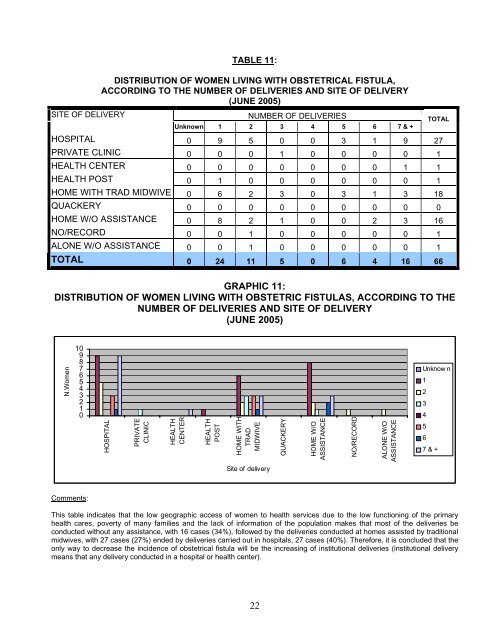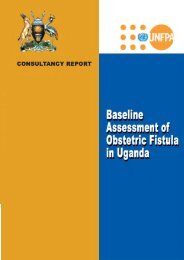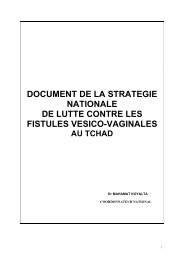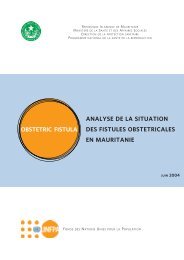Equatorial Guinea - Campaign to End Fistula
Equatorial Guinea - Campaign to End Fistula
Equatorial Guinea - Campaign to End Fistula
Create successful ePaper yourself
Turn your PDF publications into a flip-book with our unique Google optimized e-Paper software.
TABLE 11:<br />
DISTRIBUTION OF WOMEN LIVING WITH OBSTETRICAL FISTULA,<br />
ACCORDING TO THE NUMBER OF DELIVERIES AND SITE OF DELIVERY<br />
(JUNE 2005)<br />
SITE OF DELIVERY<br />
NUMBER OF DELIVERIES<br />
Unknown 1 2 3 4 5 6 7 & +<br />
HOSPITAL 0 9 5 0 0 3 1 9 27<br />
PRIVATE CLINIC 0 0 0 1 0 0 0 0 1<br />
HEALTH CENTER 0 0 0 0 0 0 0 1 1<br />
HEALTH POST 0 1 0 0 0 0 0 0 1<br />
HOME WITH TRAD MIDWIVE 0 6 2 3 0 3 1 3 18<br />
QUACKERY 0 0 0 0 0 0 0 0 0<br />
HOME W/O ASSISTANCE 0 8 2 1 0 0 2 3 16<br />
NO/RECORD 0 0 1 0 0 0 0 0 1<br />
ALONE W/O ASSISTANCE 0 0 1 0 0 0 0 0 1<br />
TOTAL 0 24 11 5 0 6 4 16 66<br />
TOTAL<br />
GRAPHIC 11:<br />
DISTRIBUTION OF WOMEN LIVING WITH OBSTETRIC FISTULAS, ACCORDING TO THE<br />
NUMBER OF DELIVERIES AND SITE OF DELIVERY<br />
(JUNE 2005)<br />
N.Women<br />
10<br />
9<br />
8<br />
7<br />
6<br />
5<br />
4<br />
3<br />
2<br />
1<br />
0<br />
HOSPITAL<br />
PRIVATE<br />
CLINIC<br />
HEALTH<br />
CENTER<br />
HEALTH<br />
POST<br />
HOME WITH<br />
TRAD<br />
MIDWIVE<br />
QUACKERY<br />
HOME W/O<br />
ASSISTANCE<br />
NO/RECORD<br />
ALONE W/O<br />
ASSISTANCE<br />
Unknow n<br />
1<br />
2<br />
3<br />
4<br />
5<br />
6<br />
7 & +<br />
Site of delivery<br />
Comments:<br />
This table indicates that the low geographic access of women <strong>to</strong> health services due <strong>to</strong> the low functioning of the primary<br />
health cares, poverty of many families and the lack of information of the population makes that most of the deliveries be<br />
conducted without any assistance, with 16 cases (34%), followed by the deliveries conducted at homes assisted by traditional<br />
midwives, with 27 cases (27%) ended by deliveries carried out in hospitals, 27 cases (40%). Therefore, it is concluded that the<br />
only way <strong>to</strong> decrease the incidence of obstetrical fistula will be the increasing of institutional deliveries (institutional delivery<br />
means that any delivery conducted in a hospital or health center).<br />
22















